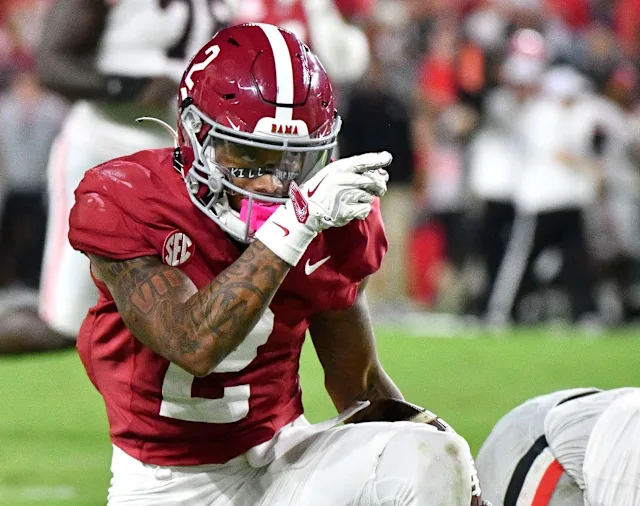When EA Sports announced the return of its long-dormant College Football video game franchise, fans were ecstatic. After more than a decade without a new installment, EA Sports College Football 26 became one of the most anticipated sports games of the year. But beyond the excitement, hype, and updated graphics, the early release of team and player ratings sparked waves of discussion — especially around Alabama. The Crimson Tide, entering a transition era following the retirement of legendary coach Nick Saban, have found themselves rated as one of the top teams in the game. This has left fans, analysts, and rival programs wondering: does EA Sports know something the rest of us don’t?
The 2025 Alabama Crimson Tide are a team in flux. The post-Saban reality has introduced more questions than answers for one of the most dominant programs in college football history. Yet, EA Sports College Football 26 has seemingly doubled down on Alabama’s prestige, granting them high ratings, elite-tier player metrics, and a projection that places them among the national elite. These ratings didn’t appear randomly — the developers worked in collaboration with analytics firms, insider scouts, and real data to craft what they believe is a realistic portrayal of the upcoming season. If that’s the case, then perhaps this virtual Alabama team is pointing toward a very real, very serious resurgence in 2025.
Ty Simpson, the projected starting quarterback, is one of the players who benefited most from the game’s optimistic assessment. Though Simpson hasn’t fully cemented himself as a college football star on the field just yet, EA has given him a high awareness rating, quick decision-making traits, and above-average mobility. That sort of digital profile suggests the developers see Simpson as someone ready to take control of Alabama’s offense in a big way — a sentiment echoed by recent comments from the coaching staff who say he gives the Tide “the best chance to win in any situation.”
It’s not just Simpson who gets the benefit of the doubt in the game. The Tide’s offensive line is ranked as one of the most cohesive units, while the defense — even without marquee returning names — receives elite grades in speed, awareness, and overall execution. There’s a belief embedded in these ratings that Alabama won’t just survive the post-Saban transition; they might actually thrive in it. The defense is projected to be especially stingy, particularly against the pass, which is a nod to the depth and athleticism Alabama still boasts in the secondary.
So where does EA Sports get this confidence from?
Some of it likely stems from recruiting. Even as the coaching carousel spun following Saban’s departure, Alabama maintained a high level of recruiting success. Their 2024 and early 2025 classes are loaded with blue-chip prospects, and College Football 26 appears to factor that in heavily. Freshman and sophomore talents, many of whom haven’t yet taken meaningful college snaps, have been rated with strong upside and starter-ready attributes. This shows a belief in Alabama’s developmental pipeline — an acknowledgment that, even without Saban, the machine he built is still humming.
Another part of the equation is likely coaching. Kalen DeBoer, who took over the reins in Tuscaloosa, is no stranger to winning. His success at Washington and his ability to modernize offenses has made him a fast riser in the coaching ranks. The game reflects that by boosting Alabama’s playbook options and coaching impact ratings, a unique new feature in the franchise. DeBoer’s schemes are expected to bring a level of innovation that allows Alabama’s offensive weapons to be fully unleashed — and in the virtual world, that makes them dangerous.
But real-world football doesn’t always follow a script — especially one written by video game developers. Alabama will still need to face daunting SEC matchups, an unforgiving schedule, and the psychological pressure of trying to live up to a dynasty’s legacy. The Tide’s offensive line must gel in real time. The defense must find leaders. And Simpson must prove he’s capable of delivering when it matters most. There are still too many unknowns to confidently say Alabama is a true national title contender in 2025. That’s what makes the game’s high rating of the team so intriguing — and potentially telling.
Perhaps EA Sports College Football 26 is offering fans more than just entertainment. Perhaps it’s functioning as an early analytics-based forecast, a projection rooted in more sophisticated modeling than many realize. The developers have confirmed that they worked closely with data-driven experts to simulate scenarios, gauge development curves, and account for team chemistry metrics. If Alabama is rated high in those simulations, it could mean that behind closed doors — inside practices, internal scouting reports, and analytics databases — there’s a level of optimism that hasn’t yet trickled into the mainstream narrative.
Alabama players have noticed the game’s ratings too. Many have shared their excitement or frustration on social media, using the game’s assessments as both a point of pride and motivation. For younger players, high ratings are a boost of confidence. For those who feel overlooked, it’s another reason to prove the world — and the algorithms — wrong. This has created a culture where the virtual world and the real one are more intertwined than ever. For Alabama, that blend may work in their favor. With a new coaching staff hungry to prove itself and a roster full of untested but talented athletes, the added motivation could be fuel for a breakout season.
It’s also worth noting that EA Sports has historically had a decent track record with projecting football success. Past editions of their games have correctly foreshadowed breakout stars, team rises, and even under-the-radar Heisman campaigns. This doesn’t mean every prediction will come true, but it does suggest that the team behind the game does their homework — and that their projections should at least be taken seriously.
There’s also the matter of reputation. Alabama might no longer have Saban on the sidelines, but the program’s culture is deeply embedded in college football. That identity — of discipline, consistency, and excellence — doesn’t vanish overnight. In the world of College Football 26, where intangibles like program prestige and team discipline are now rated attributes, Alabama still scores near the top. EA Sports is betting that the infrastructure built over the last decade-plus is strong enough to weather change. If they’re right, Alabama might not just be good — they might be elite once again.
As fans begin to explore the game, experiment with dynasty modes, and simulate their own seasons, they’ll be watching to see if virtual Alabama lives up to its lofty potential. But more importantly, they’ll be watching the real Alabama this fall. The question will linger in the minds of fans, analysts, and opposing coaches alike: did EA Sports overrate the Tide, or are they the first to recognize what’s really coming?
Only time will tell. But one thing’s certain — EA Sports College Football 26 has added a whole new layer of intrigue to Alabama’s 2025 season. Whether it’s a digital mirage or an early glimpse into a dominant resurgence, one can’t help but feel like the game might know something we don’t. And that possibility is what makes this year’s game — and this year’s Alabama team — so fascinating to watch.



